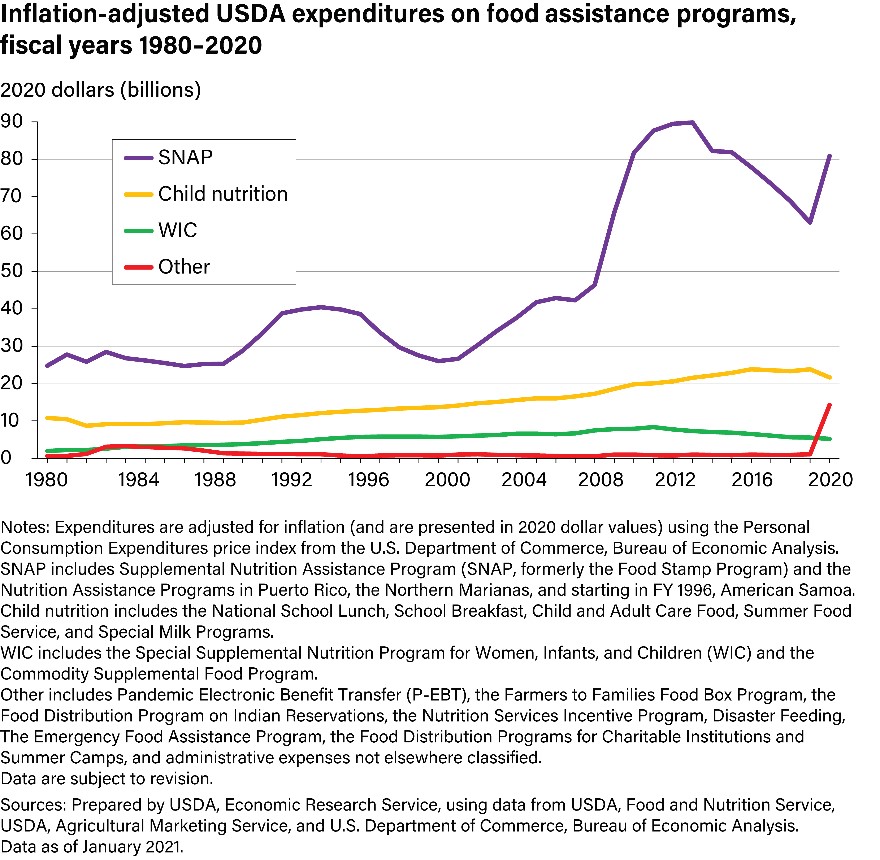
Throughout the pandemic, news headlines painted an unparalleled crisis of Americans going hungry. The best data sources largely showed these claims were exaggerated, but that hasn’t stopped the hyperboles. One news outlet wrote that during the December 2020 holidays “millions of people in the US will go literally hungry due to the deep economic crisis gripping the country.” In May 2020, The New York Times described a slow response from the federal government “as child hunger soars to levels without modern precedent.” And The Washington Post reported in November 2020 that “experts say it is likely that there’s more hunger in the United States today than at any point since 1998.”
As my AEI colleague Scott Winship and I showed in October 2020, claims of increased hunger in America due to the pandemic were greatly overstated. Instead of doubling or tripling, food insufficiency (the share of households who report sometimes or often not having enough food to eat), more likely increased by two to three percentage points during the pandemic.
The substantial and timely economic relief provided by the CARES Act and Families First Act in the early days of the pandemic likely helped prevent spikes in food insufficiency through much of 2020. According to data from the US Department of Agriculture (USDA), federal food assistance increased by 30 percent in fiscal year 2020, even without considering economic impact payments (stimulus checks) and enhanced unemployment benefits.

Despite these historic expenditures, Congress continued to expand food aid in the December 2020 relief package. They added billions in food aid amidst largely unconfirmed concerns about rising rates of hunger. The December Consolidated Appropriations Act increased the maximum SNAP benefit by another 15 percent, even after the CARES Act had increased average SNAP benefits by nearly 40 percent. This is a long-sought change by Democrats that they now hope to make permanent. President Biden issued executive actions shortly after assuming office in January 2021 to “address the growing hunger crisis facing 29 million adults — and as many as 12 million children.” And by March 2021, Congress passed the American Rescue Plan, which extended the 15 percent increase in SNAP benefits, along with extending the summer school meals program, increasing assistance to emergency food programs, and expanding the Women, Infant, and Children (WIC) supplemental food program. An analysis by the USDA found that the 15 percent increase in SNAP benefits alone meant SNAP households with four people received an additional $112 per month, on average, and the federal government spent $1.16 billion more per month in SNAP benefits.
What are the results from these substantial federal efforts to combat hunger? Trends in food insufficiency — our best measure of hunger — show only marginal changes. The US Census Bureau has surveyed a cross-section of American households every few weeks throughout the pandemic. Comparable data on food insufficiency are available since August 2020. At the end of August 2020, 10.3 percent of households reported not having enough food to eat sometimes or often, and the most recent two-week period of data collection (ending July 5, 2021) showed that 9.7 percent of households reported the same — a decline of only half a percentage point.

A closer look at the data shows that the rate of food insufficiency among American households peaked in December 2020 at 13.7 percent and declined to a low of 8.1 percent in April 2021. This is a large decline, but other factors beyond increases in food assistance likely contributed.
One reason for fluctuations in food insufficiency rates involves seasonality. The holiday season in November and December traditionally strains household budgets. Additionally, most households received two rounds of economic impact payments (stimulus checks) from the government (one in December 2020 and one in March 2021), and low-income households received their refundable tax credits around March and April 2021, further explaining changes in food insufficiency rates. Another point worth noting is that rates of food insufficiency track very well with COVID-19 case activity, suggesting that feelings of not having enough food were highly correlated with factors beyond the economic resources in a household.

No one wants to minimize the challenges faced by households during the pandemic, but these challenges should not be used as justification to expand government aid permanently. As Jason DeParle of The New York Times put it: “[T]he Biden administration is accelerating a vast campaign of hunger relief that will temporarily increase assistance by tens of billions of dollars and set the stage for what officials envision as lasting expansions of aid.” Lawmakers should look past these tactics, return food assistance to pre-pandemic levels, and focus on reforms that can help low-income families permanently get ahead.
The post Has billions more in food assistance reduced hunger in the US? appeared first on American Enterprise Institute – AEI.
